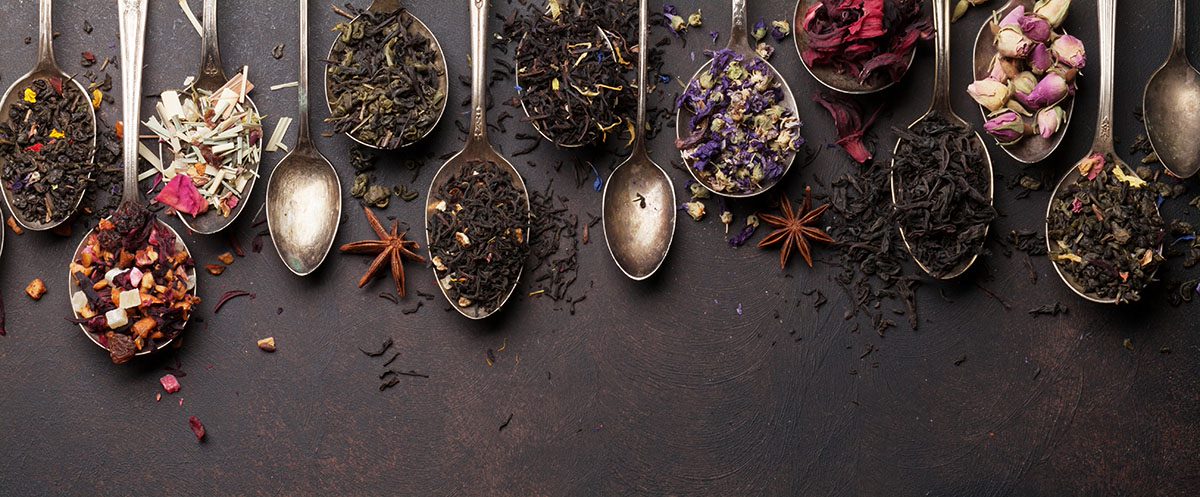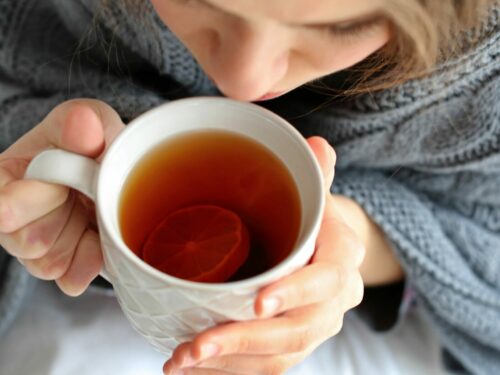
A lot of us are familiar with our standard black, green, oolong, sometimes even white and Pu-erh tea varieties, and we may have heard the term herbal tea before, but have we ever stopped to think what are the differences between them all? Before embarking on this journey of tea, I was aware of their existence, but I lacked knowledge and depth (other than the fact that I really enjoy drinking them!) But what I did learn influenced me in how I like to prepare them to get the most out of their wonderful goodness. When browsing our store, you will notice that we have a strong focus on teas of the herbal type, so let us tell you a bit about them so you can feel confident in your next purchase.
What is Herbal Tea?
Technically, herbal tea is not really a tea at all. When we look at our standard teas, we will notice that they all come from the same type of plant. Herbal tea however, is made up of an infusion of fruits, herbs, spices, and flowers which can be drunk for enjoyment or used for medicinal purposes. Even with these differences, we cannot deny herbal tea of its well deserving tea title. Herbal teas do not contain caffeine which makes them perfect for caffeine sensitive people or for children. These herbal blends come in a wide variety of types, with ingredients ranging from cinnamon, sage, lavender, lemon, rose, chamomile, and ginger.
Like all teas, which are known for their incredible health benefits, herbal tea is no different. Targeting more specific health issues depending on the remedial blend- types of healing can include colds, coughs, sore throats, insomnia, digestion, immune boosting, nausea, detox, and combating stress. Like all medicinal products, it is always advised to speak to your healthcare professional before consuming.
What is Regular Tea?
Regular teas are our good old favourites, that’s leaves are sourced from the plant species named Camellia Sinensis. Originally native to South-East Asia, East Asia, and the Indian Subcontinent, Camellia Sinensis can now be grown around the world. Traditionally each leaf was picked by hand to ensure a higher quality leaf, resulting in a tea that is more mellow and smooth. Although today, most leaves are harvested by machine. You may be asking, if all tea comes from the same plant why are there different types, tastes, and colours? Well, this is where the process of oxidation comes into things.
Oxidation is the process of a compound gaining oxygen. When the leaves are picked, they are exposed to oxygen in the air, which then causes a reaction with the natural compound called polyphenols that is found in tea leaves. This reaction converts the polyphenols into new compounds over a period of time, which then determines the type of tea. The longer the leaves are exposed, the more oxidation that occurs which irretrievably results in a darker tea.
Tea leaves undergo oxidation as soon as they are picked. To halt this process, leaves are either dried in the sun, in the oven, pan-fried, or steamed.
Green Tea
Green tea is the least oxidised tea and is steamed or pan fried as soon as it is picked to keep its leaves green, with a light and vegetal taste. It contains high antioxidants and is good for metabolism and digestion.
White Tea
White tea is the least processed out of all the teas as it is left to either air dry in the sun or in a controlled environment. Due to it taking longer to dry, white tea undergoes a little more oxidation compared to green tea. White tea usually contains a low caffeine content, and has a light, delicate flavour with a subtle sweetness. Due to being less processed, it contains even more antioxidants than green tea, boasting anti-inflammatory properties, and healthier skin.
Oolong Tea
Oolong tea is partly oxidised, sitting somewhere between green and black tea. Oolong teas can range from low to high oxidisation, where the colour of the tea can range from a pale yellow to a rich amber. Depending on the type of oolong, they are either heated for a short or longer time. Sometimes the oolong leaves are rolled into small balls before they are dried. Light oxidised oolongs have a light and refreshing flavour with notes of floral, whereas high oxidised oolongs are full-bodied, roasted, with notes of caramel and chocolate. Alongside antioxidants, oolong tea helps to lower cholesterol and aids in weight loss.
Black Tea
Black tea is fully oxidised by heating the leaves until they turn a dark brown/ black colour. The flavour of black tea can be bold, malty, and smoky. It has a high caffeine content, contains antioxidants, and is good for our heart health.
Pu-erh Tea
Pu-erh tea is the most oxidised out of all the teas, undergoing the same process as green tea, in where it is pan fried, however, Pu-erh is done at lower temperatures, allowing for further transformation. There are two types of Pu-erh tea, one is raw Pu-erh, and the other is ripe Pu-erh. What makes Pu-erh tea different from other regular teas is how it also undergoes a fermentation process, allowing for oxidation to continue. Raw Pu-erh tea takes on the traditional method, where it is left to age over a very long period of time. Raw Pu-erh that is not well aged, will result in a lighter coppery brew. Whereas ripe Pu-erh undergoes an accelerated process of fermentation that gives it its dark red colour. Ripe Pu-erh is the darkest of all the teas and closely resembles black tea in terms of colour, flavour, and caffeine level. Raw Pu-erh that has been aged is similar in profile, but has an increased complexity of flavour. Both types are high in antioxidants and vitamin C, promoting skin health, and stress relief.
How to Prepare
Understanding a bit about these teas can help us to work out how we enjoy them. Again, I do not believe in a one fits all method, but I can share some of my own recommendations, which may or may not work for you. For herbal teas I prefer to use hot water (not quite boiling), and to steep for longer compared to regular teas. I find if I steep my herbal ones for a short amount of time, they have not quite developed in flavour, and the taste is a little watered down. Whereas if I steep anywhere from 8-10 minutes, I feel it gives enough time for the flavours to enhance and is a nice temperature to drink.
For regular teas, the time may vary on the type of tea. You may notice our Classic Turkish Black Tea recommends brewing for 15 minutes, this is because for Turkish black tea, the longer the brew, the more optimum the flavour. For regular black tea I normally do around 3 minutes, same goes for Pu-erh tea. With green tea and oolong tea the 3 minutes rule applies, yet I tend to brew them with boiling water mixed with cool water to balance out the temperature as I find it results in a less harsh tea. As for white tea, I also recommend the same water temperature as if it is too hot it can damage the leaves. I also find steeping it for slightly longer, around five minutes for its delicate leaves to release its flavour.
Now you know a bit more about the types of teas, go and experiment with your own methods and see what works for you!



XMC.PL
The elegance in your writing is apparent in every line, creating a sense of harmony that lingers.